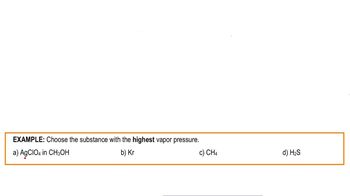Olympic cyclists fill their tires with helium to make them lighter. Calculate the mass of air in an air-filled tire and the mass of helium in a helium-filled tire. Assume that the volume of the tire is 855 mL, that it is filled to a total pressure of 125 psi, and that the temperature is 25 °C. Also, assume an average molar mass for air of 28.8 g/mol. What is the mass difference between the two?
Twenty-five milliliters of liquid nitrogen (density = 0.807 g/mL) is poured into a cylindrical container with a radius of 10.0 cm and a length of 20.0 cm. The container initially contains only air at a pressure of 760.0 mmHg (atmospheric pressure) and a temperature of 298 K. If the liquid nitrogen completely vaporizes, what is the total force (in lb) on the interior of the container at 298 K?
 Verified step by step guidance
Verified step by step guidanceKey Concepts
Ideal Gas Law

Density and Mass Calculation

Force and Pressure Relationship

An ordinary gasoline can measuring 30.0 cm by 20.0 cm by 15.0 cm is evacuated with a vacuum pump. Assuming that virtually all of the air can be removed from inside the can and that atmospheric pressure is 14.7 psi, what is the total force (in pounds) on the surface of the can? Do you think that the can could withstand the force?
An 11.5-mL sample of liquid butane (density = 0.573 g/mL) is evaporated in an otherwise empty container at a temperature of 28.5 °C. The pressure in the container following evaporation is 892 torr. What is the volume of the container?
A scuba diver creates a spherical bubble with a radius of 2.5 cm at a depth of 30.0 m where the total pressure (including atmospheric pressure) is 4.00 atm. What is the radius of the bubble when it reaches the surface of the water? (Assume that the atmospheric pressure is 1.00 atm and the temperature is 298 K.)
